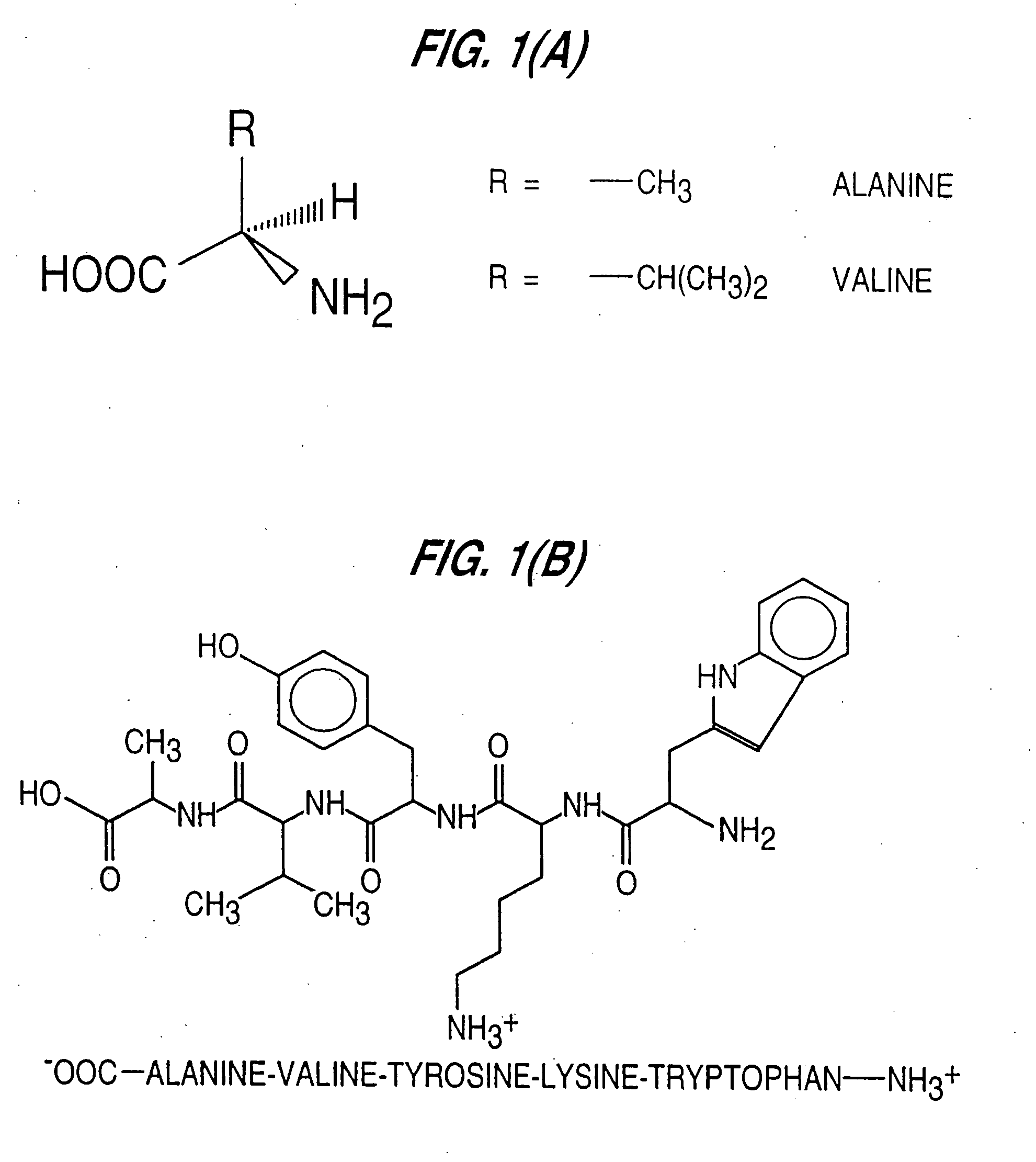Detection of markers in nascent proteins
a technology of markers and proteins, applied in the field of non-radioactive markers, can solve the problems of time-consuming health risks in the laboratory, and the use of radioactive labeling suffers from many drawbacks ,
- Summary
- Abstract
- Description
- Claims
- Application Information
AI Technical Summary
Benefits of technology
Problems solved by technology
Method used
Image
Examples
example 1
Preparation of Markers
[0126] Synthesis of Coumarin Amino Acid: 4-(Bromomethyl)-7-methoxy coumarin (FIG. 15, compound 1; 6.18 mrole) and diethylacetamidomalonate (FIG. 15, compound 2; 6.18 mmole) were added to a solution of sodium ethoxide in absolute ethanol and the mixture refluxed for 4 hours. The intermediate obtained (FIG. 15, compound 3) after neutralization of the reaction mixture and chloroform extraction was further purified by crystalization from methanolic solution. This intermediate was dissolved in a mixture of acetone and HCl (1:1) and refluxed for one hour. The reaction mixture was evaporated to dryness, and the amino acid hydrochloride precipitated using acetone. This hydrochloride was converted to free amino acid (FIG. 15, compound 4) by dissolving in 50% ethanol and adding pyridine to pH 4-5. The proton (1H) NMR spectrum of the free amino acid was as follows: (m.p. 274-276° C., decomp.) —OCH3 (δ 3.85 s, 3H), —CH2-(δ 3.5 d, 2H), α-CH— (δ 2.9 t, 1H), CH—CO (δ 6.25 s,...
example 2
Misaminoacylation of tRNA
[0129] The general strategy used for generating misaminoacylated tRNA is shown in FIG. 16 and involved truncation of tRNA molecules, dinucleotide synthesis (FIG. 17), aminoacylation of the dinucleotide (FIG. 18) and ligase mediated coupling.
[0130] a) Truncated tRNA molecules were generated by periodate degradation in the presence of lysine and alkaline phosphatase basically as described by Neu and Heppel (J. Biol. Chem. 239:2927-34, 1964). Briefly, 4 mmoles of uncharged E. coli tRNALys molecules (Sigma Chemical; St. Louis, Mo.) were truncated with two successive treatments of 50 mM sodium metaperiodate and 0.5 M lysine, pH 9.0, at 60° C. for 30 minutes in a total volume of 50 μl. Reaction conditions were always above 50° C. and utilized a 10-fold excess of metaperiodate. Excess periodate was destroyed treatment with 5 μl of IM glycerol. The pH of the solution was adjusted to 8.5 by adding 15 μl of Tris-HCl to a final concentration of 0.1 M. The reaction vo...
example 3
Preparation of Extract and Template for Cell-Free Translation
[0137] Preparation of extract: Wheat germ embryo extract was prepared by floatation of wheat germs to enrich for embryos using a mixture of cyclohexane and carbon tetrachloride (1:6), followed by drying overnight (about 14 hours). Floated wheat germ embryos (5 g) were ground in a mortar with 5 grams of powdered glass to obtain a fine powder. Extraction medium (Buffer 1:10 mM trisacetate buffer, pH 7.6, 1 nM magnesium acetate, 90 mM potassium acetate, and 1 mM DTT) was added to small portions until a smooth paste was obtained. The homogenate containing disrupted embryos and 25 ml of extraction medium was centrifuged twice at 23,000×g. The extract was applied to a Sephadex G-25 fine column and eluted in Buffer II (10 mM trisacetate buffer, pH 7.6, 3 mM magnesium acetate, 50 mM potassium acetate, and 1 mM DTT). A bright yellow band migrating in void volume and was collected (S-23) as one ml fractions which were frozen in liq...
PUM
| Property | Measurement | Unit |
|---|---|---|
| pH | aaaaa | aaaaa |
| temperature | aaaaa | aaaaa |
| temperature | aaaaa | aaaaa |
Abstract
Description
Claims
Application Information
 Login to View More
Login to View More - R&D
- Intellectual Property
- Life Sciences
- Materials
- Tech Scout
- Unparalleled Data Quality
- Higher Quality Content
- 60% Fewer Hallucinations
Browse by: Latest US Patents, China's latest patents, Technical Efficacy Thesaurus, Application Domain, Technology Topic, Popular Technical Reports.
© 2025 PatSnap. All rights reserved.Legal|Privacy policy|Modern Slavery Act Transparency Statement|Sitemap|About US| Contact US: help@patsnap.com



